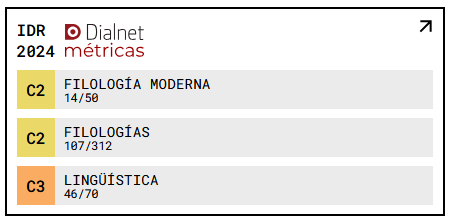Abstract Machines in J. G. Ballard’s "High-rise"
DOI:
https://doi.org/10.18172/jes.5552Keywords:
J. G. Ballard, High-Rise, Deleuze & Guattari, Abstract Machine, Rhizome, SchizophreniaAbstract
This article sets out to explore how J. G. Ballard’s High-Rise (1975) can be read through Deleuze and Guattari’s concepts of rhizome, abstract machines and schizophrenia. The social structure of the Seventies in England, High-Rise as a building and High Rise as a novel are connected to one another to portray a rhizome that manifests a dystopian answer to the inquiry of human nature. High-Rise can be studied as an abstract machine since it is a machine of fiction through which the readers question the meaning of humanity. High-Rise, the building, is also an abstract machine in itself since it operates as a means to reveal the constant process of becoming under late capitalism. Therefore, this article aims to reveal the Deleuze-Guattarian dynamics in High-Rise in relation to High-Rise, the building, by focusing on the social elements that expose the schizophrenic aspects of late capitalism.
Downloads
References
Ballard, J. G. 2012. High-Rise. New York: Liveright Publishing.
Ballard, J. G. and J. Lewis. 1991. “An Interview with J. G. Ballard”. Mississipi Review, 20 (1/2): 27-40. <https://www.jstor.org/stable/20134507>. (Accessed 23 May 2022).
Beckman, F. 2013. “Chronopolitics”. Symplokē, 21.1-2: 279-89.
Bradshaw, A. and S. Brown. 2018. “Up Rising: Rehabilitating J. G. Ballard’s High-Rise with R. D. Laing and Lauren Berlant”. Environment and Planning D: Society and Space, 36 (2): 1-19. https://doi.org/10.1177/0263775817748329
Butterfield, B. J. 1999. “Ethical Value and Negative Aesthetics: Reconsidering the Baudrillard-Ballard Connection”. PMLA, 114 (1): 64-77. <https://www.jstor.org/stable/463427>. (Accessed 23 May 2022).
Cappon, D. 1971. “Mental Health in the High-Rise”. Canadian Journal of Public Health, 62 (5): 426-31. <https://www.jstor.org/stable/41986998>. (Accessed 23 May 2022).
Caserio, R. L. 1988. “Mobility and Masochism: Christine Brooke-Rose and J. G. Ballard”. NOVEL: A Forum on Fiction, 21 (2/3): 292-310.
Davies, J. 2017. “Transition, Abstraction and Perverse Concreteness in J.G. Ballard’s High-Rise”. Textual Practice, 32 (10): 1741-1761. https://doi.org/10.1080/0950236X.2017.1301546
Deleuze, G. and F. Guattari. 1984. “Concrete Rules and Abstract Machines”. SubStance 13 (3/4): 7-19. <https://www.jstor.org/stable/3684771>. (Accessed 25 May 2022).
Deleuze, G. and F. Guattari. 2000 (1983). Anti-Oedipus: Capitalism and Schizophrenia. Minneapolis: University of Minnesota Press. Trans. Robert Hurley, Mark Seem, Helen R. Lane.
Deleuze, G. and F. Guattari. 2005 (1987). A Thousand Plateaus: Capitalism and Schizophrenia. London: Athlone Press. Trans. Brian Massumi.
Doxiadis, C. A. and D. Hill. 1972. “Inhuman High-Rise apartments”. Ekistics, 33 (197): 296-299. <https://www.jstor.org/stable/43621711>. (Accessed 23 May 2022).
Gray, J. 2019. “J G Ballard and the Phenomenology of the Absence of Law”. Law and Humanities, 13: 148-176. https://doi.org/10.1080/17521483.2019.1676522
Groes, S. 2012. “The Texture of Modernity in J. G. Ballard’s Crash, Concrete Island and High-Rise”. J. G. Ballard: Visions and Revisions. Eds. J. Baxter & R. Wymer. New York: Palgrave Macmillan. 123-141.
Fässler, R. “The Vertical Deconstruction of Public life: An Analysis of the Evolution of Chaos in a Lack of Public Spaces in J.G. Ballard’s High-Rise”. https://doi.org/10.13140/RG.2.2.32065.79202
Hatherley, O. 2016. “Crimes of the Retro-future: Historicising J. G. Ballard and Ben Wheatley’s High-Rises”. Critical Quarterly, 58 (1): 70-5. https://doi.org/10.1111/criq.12251
Hoa, J. H. B. 2012. “Pornographic Geometries: The Spectacle as Pathology and as Therapy in The Atrocity Exhibition”. J. G. Ballard: Visions and Revisions. Eds. J. Baxter and R. Wymer. New York: Palgrave Macmillan. 71-87.
Massumi, B. 1996. A User’s Guide to Capitalism and Schizophrenia: Deviations from Deleuze and Guattari. London: MIT.
Matthews, G. Winter 2013. “Consumerism’s Endgame: Violence and Community in J.G. Ballard’s Late Fiction”. Journal of Modern Literature, 36 (2): 122-139.
Morgan, K. O. 2017. “Britain in the Seventies – Our Unfinest Hour?”. French Journal of British Studies, 1-17. <https://journals.openedition.org/rfcb/1662>. (Accessed 21 September 2021).
Orr, L. June 2000. “The Utopian Disasters of J. G. Ballard”. CLA Journal, 43 (4): 479-93. <https://www.jstor.org/stable/44325010>. (Accessed 23 May 2022).
Sellers, S. & O’Hara D., eds. 2012. Extreme Metaphors: Selected Interviews with J. G. Ballard, 1967-2008. London: Fourth Estate.
Stephenson, G. 1991. Out of the Night and into the Dream: A Thematic Study of the Fiction of J. G. Ballard. New York: Greenwood.
Stoner, J. 2013. “High Optimism”. Cityscape, 15 (3): 179-1-82. <https://www.jstor.org/stable/10.2307/26326840>. (Accessed 23 May 2022).
Surin, K. 1991. “The Undecidable and the Fugitive: “Mille Plateaux” and the State-form”. SubStance, 20 (3), 66: 102-13.
Wagar, W. W. March 1991. “J. G. Ballard and the Transvaluation of Utopia”. Science Fiction Studies, 18.1: 53-70.
Wilson, D. H. 2017. J. G. Ballard. Chicago: University of Illinois Press.
Wood, J. C. 2017. “‘Going Mad Is Their Only Way of Staying Sane’: Norbert Elias and the Civilized Violence of J. G. Ballard”. J. G. Ballard: Visions and Revisions. Eds. J. Baxter & R. Wymer. New York: Palgrave Macmillan. 198-214.
Downloads
Published
How to Cite
Issue
Section
License
Copyright (c) 2023 Begüm Tuğlu Atamer

This work is licensed under a Creative Commons Attribution 4.0 International License.
The authors retain copyright of articles and authorize Journal of English Studies the first publication. They are free to share, redistribute, and/or reprint the article without obtaining permission from the publisher as long as they give appropriate credit to the editor and the journal.
Self-archiving is allowed too. In fact, it is recommendable to deposit a PDF version of the paper in academic and/or institutional repositories.
It is recommended to include the DOI number.
This journal is licensed under a Creative Commons Attribution 4.0 International License













